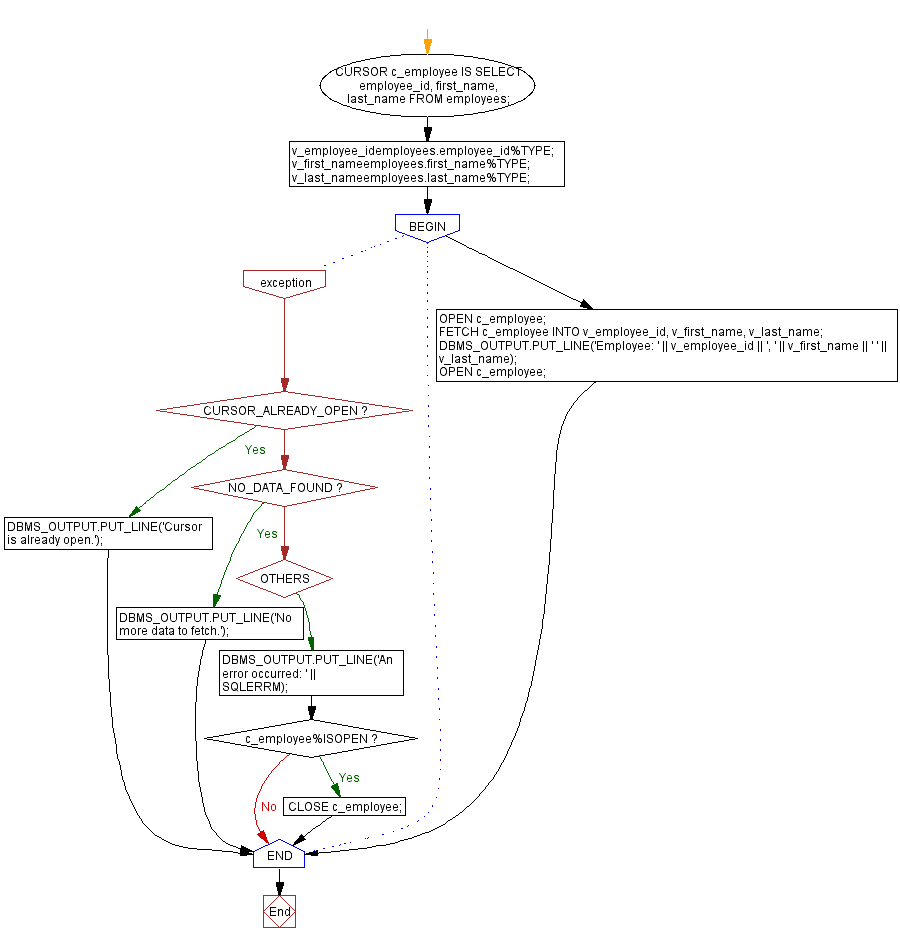Example of handling CURSOR_ALREADY_OPEN exception in PL/SQL cursors
PL/SQL Exception Handling: Exercise-8 with Solution
Handle the CURSOR_ALREADY_OPEN exception when trying to open a cursor that is already open.
Sample Solution:
Table: employees
employee_id integer first_name varchar(25) last_name varchar(25) email archar(25) phone_number varchar(15) hire_date date job_id varchar(25) salary integer commission_pct decimal(5,2) manager_id integer department_id integer
PL/SQL Code:
DECLARE
CURSOR c_employee IS
SELECT employee_id, first_name, last_name FROM employees;
v_employee_idemployees.employee_id%TYPE;
v_first_nameemployees.first_name%TYPE;
v_last_nameemployees.last_name%TYPE;
BEGIN
OPEN c_employee;
FETCH c_employee INTO v_employee_id, v_first_name, v_last_name;
DBMS_OUTPUT.PUT_LINE('Employee: ' || v_employee_id || ', ' || v_first_name || ' ' || v_last_name);
OPEN c_employee;
EXCEPTION
WHEN CURSOR_ALREADY_OPEN THEN
DBMS_OUTPUT.PUT_LINE('Cursor is already open.');
WHEN NO_DATA_FOUND THEN
DBMS_OUTPUT.PUT_LINE('No more data to fetch.');
WHEN OTHERS THEN
DBMS_OUTPUT.PUT_LINE('An error occurred: ' || SQLERRM);
BEGIN
IF c_employee%ISOPEN THEN
CLOSE c_employee;
END IF;
END;
END;
/
Sample Output:
Employee: 100, Steven King Cursor is already open.
Explanation:
The said code in Oracle's PL/SQL demonstrates the handling of the CURSOR_ALREADY_OPEN exception and properly closing the cursor, the code ensures the correct and efficient management of the cursor and avoids any potential issues caused by attempting to open an already open cursor.
The cursor named c_employee that selects employee IDs, first names, and last names from a table called employees is declared.
The three variables v_employee_id, v_first_name, v_last_name are declared to hold the fetched values from the cursor.
Then the cursor c_employee starts to fetch the first row of data into the declared variables and the fetched information displays by using the DBMS_OUTPUT.PUT_LINE procedure.
The CURSOR_ALREADY_OPEN exception raised if the cursor is already open and in such a case, the code handeles exception by displaying a message: 'Cursor is already open.'
An other exception the NO_DATA_FOUND raised when there are no more rows to fetch from the cursor. It displays a message indicating 'No more data to fetch.'
The OTHERS exception if raised during the execution of the code, displays a generic error message along with the error message provided by SQLERRM.
A block that checks whether the cursor c_employee is open using the %ISOPEN attribute and if so the nested block closes the cursor using the CLOSE statement to ensure proper cursor management.
Flowchart:

Go to:
PREV : PL/SQL Program Handling Internal Error.
NEXT : Handling INVALID_CURSOR Exception.
Have another way to solve this solution? Contribute your code (and comments) through Disqus.
What is the difficulty level of this exercise?
